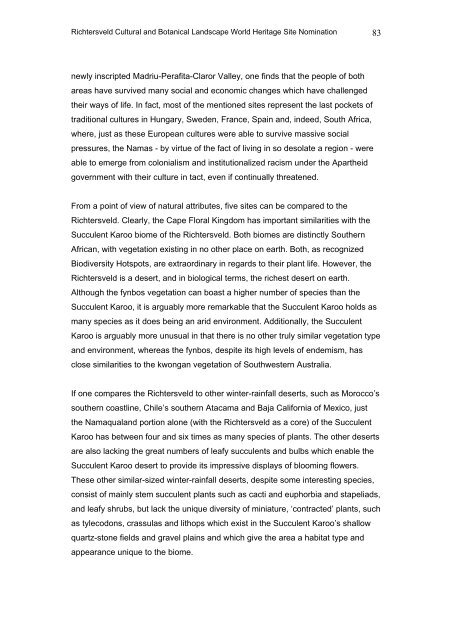the richtersveld cultural and botanical landscape - SAHRA
the richtersveld cultural and botanical landscape - SAHRA
the richtersveld cultural and botanical landscape - SAHRA
You also want an ePaper? Increase the reach of your titles
YUMPU automatically turns print PDFs into web optimized ePapers that Google loves.
Richtersveld Cultural <strong>and</strong> Botanical L<strong>and</strong>scape World Heritage Site Nomination 83<br />
newly inscripted Madriu-Perafita-Claror Valley, one finds that <strong>the</strong> people of both<br />
areas have survived many social <strong>and</strong> economic changes which have challenged<br />
<strong>the</strong>ir ways of life. In fact, most of <strong>the</strong> mentioned sites represent <strong>the</strong> last pockets of<br />
traditional cultures in Hungary, Sweden, France, Spain <strong>and</strong>, indeed, South Africa,<br />
where, just as <strong>the</strong>se European cultures were able to survive massive social<br />
pressures, <strong>the</strong> Namas - by virtue of <strong>the</strong> fact of living in so desolate a region - were<br />
able to emerge from colonialism <strong>and</strong> institutionalized racism under <strong>the</strong> Apar<strong>the</strong>id<br />
government with <strong>the</strong>ir culture in tact, even if continually threatened.<br />
From a point of view of natural attributes, five sites can be compared to <strong>the</strong><br />
Richtersveld. Clearly, <strong>the</strong> Cape Floral Kingdom has important similarities with <strong>the</strong><br />
Succulent Karoo biome of <strong>the</strong> Richtersveld. Both biomes are distinctly Sou<strong>the</strong>rn<br />
African, with vegetation existing in no o<strong>the</strong>r place on earth. Both, as recognized<br />
Biodiversity Hotspots, are extraordinary in regards to <strong>the</strong>ir plant life. However, <strong>the</strong><br />
Richtersveld is a desert, <strong>and</strong> in biological terms, <strong>the</strong> richest desert on earth.<br />
Although <strong>the</strong> fynbos vegetation can boast a higher number of species than <strong>the</strong><br />
Succulent Karoo, it is arguably more remarkable that <strong>the</strong> Succulent Karoo holds as<br />
many species as it does being an arid environment. Additionally, <strong>the</strong> Succulent<br />
Karoo is arguably more unusual in that <strong>the</strong>re is no o<strong>the</strong>r truly similar vegetation type<br />
<strong>and</strong> environment, whereas <strong>the</strong> fynbos, despite its high levels of endemism, has<br />
close similarities to <strong>the</strong> kwongan vegetation of Southwestern Australia.<br />
If one compares <strong>the</strong> Richtersveld to o<strong>the</strong>r winter-rainfall deserts, such as Morocco’s<br />
sou<strong>the</strong>rn coastline, Chile’s sou<strong>the</strong>rn Atacama <strong>and</strong> Baja California of Mexico, just<br />
<strong>the</strong> Namaqual<strong>and</strong> portion alone (with <strong>the</strong> Richtersveld as a core) of <strong>the</strong> Succulent<br />
Karoo has between four <strong>and</strong> six times as many species of plants. The o<strong>the</strong>r deserts<br />
are also lacking <strong>the</strong> great numbers of leafy succulents <strong>and</strong> bulbs which enable <strong>the</strong><br />
Succulent Karoo desert to provide its impressive displays of blooming flowers.<br />
These o<strong>the</strong>r similar-sized winter-rainfall deserts, despite some interesting species,<br />
consist of mainly stem succulent plants such as cacti <strong>and</strong> euphorbia <strong>and</strong> stapeliads,<br />
<strong>and</strong> leafy shrubs, but lack <strong>the</strong> unique diversity of miniature, ‘contracted’ plants, such<br />
as tylecodons, crassulas <strong>and</strong> lithops which exist in <strong>the</strong> Succulent Karoo’s shallow<br />
quartz-stone fields <strong>and</strong> gravel plains <strong>and</strong> which give <strong>the</strong> area a habitat type <strong>and</strong><br />
appearance unique to <strong>the</strong> biome.

















